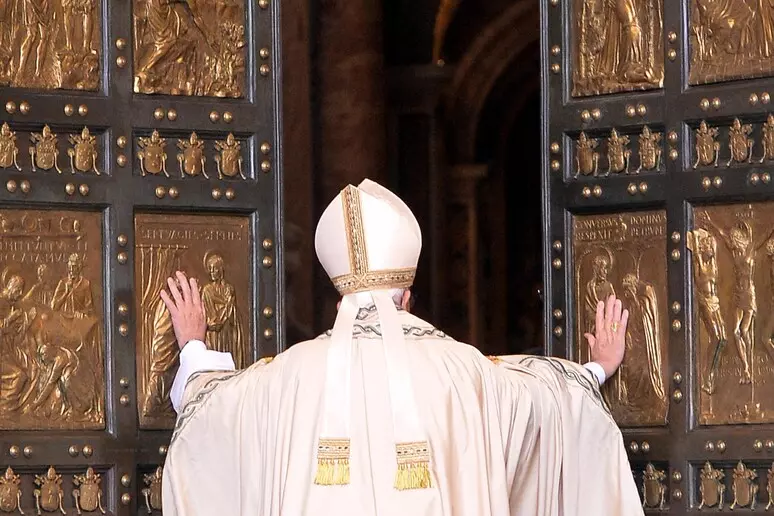With the opening of the Holy Door and an impressive ceremony in St. Peter’s Basilica, Pope Francis inaugurated Jubilee 2025, which is expected to bring more than 30 million pilgrims to Rome in the coming months. The rite was followed by the Christmas Mass officiated by the Pontiff, with Prime Minister Giorgia Meloni in attendance, among others. St. Peter’s Square was impressively packed with faithful despite the cold weather.
The Jubilee, also known as the Holy Year, is an exceptional and solemn event in the Catholic Church that takes place every 25 years. This year, Francis dedicated the event – which will last from Dec. 24, 2024 to Jan. 6, 2026 – to Hope. It is the second ordinary Jubilee presided over by Bergoglio, following the 2015 extraordinary Jubilee dedicated to Mercy. The tradition has deep roots dating back to the Old Testament: every 50th year a special time of freedom and reconciliation was proclaimed, when debts were canceled, slaves freed and lands returned to their original owners. The Jubilee in its modern version was promulgated by Pope Boniface VIII in the Middle Ages as a means of remission of sins. In short, the pilgrim who passes through the Holy Door obtains it, only if they are repentant.
Already from the early afternoon hours the faithful had queued up at the gates for metal detector checks, amidst imposing security measures; the risk of terrorism was considered high by the security detail.
It is thus a religious occasion of great importance for the world’s Catholic faithful, but it also has a great impact on the Italian economy in terms of tourism. The Italian government also hopes that the pilgrims who will flock to Rome will then go on to explore the rest of the peninsula and contribute to other local economies.
The last few months have been difficult for Roman citizens as the city is overrun by construction sites. Around the Vatican, several areas have been pedestrianized in just the last few days to accommodate religious pilgrims, such as the so-called Castel Sant’Angelo underpass, Via Ottaviano leading toward the Vatican, and Piazza Pia, which spreads out from the end of Via della Conciliazione, overlooking the Bernini colonnade and St. Peter’s Square.
“Over the past two years we have all worked well to make sure that the Eternal City is up to the task,” Giorgia Meloni said at the inauguration ceremony of the restyled Piazza Pia. The new automobile underpass and the pedestrianization of the square between Castel Sant’Angelo and St. Peter’s Basilica represent “the most impressive work, costing 85 million euros, which will create a space for 150 thousand people because of the Jubilee events,” she said. The premier commended “the spirit of collaboration” that animated all those involved, starting with the Capitoline administration of Roberto Gualtieri, the mayor of the very same Democratic Party that leads the opposition. According to Meloni, “the method this government has used has been crucial: a control room capable of dealing in real time with challenges as they came up.” In short, she boasted, “a small miracle of cross-party civility. We can call it the Jubilee method.”
According to the Rome Chamber of Commerce, “each of the scenarios developed shows how the Jubilee will contribute positively, with particularly significant effects on the Services sector, where an increase in the product of between 87.2 percent and 87.4 percent is expected.” Stores, restaurants, transportation, museums, and guided tours will count on the boost in income over the next twelve months. The impact on the luxury hotel sector is less certain, partly because most pilgrims will flow into hospitality facilities managed by the Vatican itself. According to the Observatory on the Economy of Tourism of the Chambers of Commerce, however, spending by pilgrims in Rome alone will reach nearly 17 billion euros.
Some are less optimistic. Rome has received a total of 1.8 billion euros for projects related to the Jubilee 2025, including 1.3 billion managed by the Ministry of Infrastructure and Sustainable Mobility and 520 million euros in the hands of the Ministry of Tourism for recovery of archaeological areas and the enhancement of museums and new itineraries. However according to a study on the impact of the 2000 Jubilee published in 2019 by the Bank of Italy, in the immediate term, major events stimulate an increase in tourism and local demand, but “in the long term the economic benefits are uncertain and rarely exceed the costs of organization.” It concluded that the event did not enrich Rome, it impoverished it: growth in per capita value added was “negligible,” while the re-composition of labor to lower value-added sectors even led to a loss of productivity in the Roman economy.












